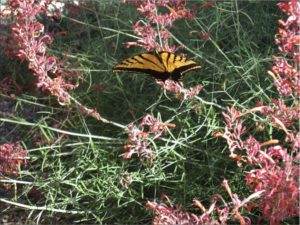Hummingbird Mint (Agastache rupestris)
By: Sarah BaldwinAlternate common names: threadleaf giant hyssop, sunset hyssop, licorice mintOne of the delights of late summer in Santa Fe is the flush of wildflowers that color arroyos, hillsides, and open lots following the monsoons. In our gardens, too, everything seems briefly revived, and certain plants finally come into their own. Chief among these are our brilliant agastaches, with their fiery, aromatic spikes of pink and orange and shifting hues within that range. Sit a while near one of these plants and you’re sure to see a hummingbird flitting ecstatically from bloom to bloom.From the enormous mint (Lamiaceae) family, agastaches are native primarily to North America. The two Southwest species responsible for most of the hybrids found in local nurseries are A. cana, with deep pink inflorescences, and A. rupestris, with soft orange trumpets and grey-green, thread-like leaves on upright stems. A rare plant in the wild, A. rupestrismakes its home on mountain slopes from 5,000 to 7,000 feet in southeastern Arizona, southwestern New Mexico, and northern Chihuahua, Mexico.Propagation and care: The species may be grown from seeds or cuttings. Hybrids should be grown from cuttings. Set out containers of A. rupestrisfrom late spring into fall. Some shade is OK, but it will bloom best in full sun. Sandy, well-drained soil is a must—A. rupestriswon’t tolerate heavy clay. Only a handful or two of compost and some Yum Yum are needed as amendments; this species likes lean soil. Mulch with crushed gravel. Water at least twice weekly in the hottest periods during the first growing season; in subsequent growing seasons, deep weekly irrigation should be sufficient.Landscape use:This plant is most striking when its pale, translucent flowers and soft form are backlit, so place it where it will catch the rays of morning or afternoon sun. It looks beautiful with other silver-foliaged plants, including yarrow, lavender, and avena grass. Late-blooming or reblooming blue-flowered plants such as catmint and Russian sage make pleasing color complements. Situate it where you can enjoy its spicy licorice scent and the show of hummingbirds and butterflies. Plant type:herbaceous perennial/subshrubFlower:tubular, 2-lipped salmon to pink with lavender calyxesBloom time:mid-summer to first frostHeight and width:2–3-foot clumpsExposure:full sun to part shadeSoil:lean, well-drainedMoisture:medium until established, then lowZones:4–9References:Salman, David. Fine Gardening, Hooked on HyssopsUSDA Forest Service, Plant of the Week Photos by Sarah Baldwin
Plant type:herbaceous perennial/subshrubFlower:tubular, 2-lipped salmon to pink with lavender calyxesBloom time:mid-summer to first frostHeight and width:2–3-foot clumpsExposure:full sun to part shadeSoil:lean, well-drainedMoisture:medium until established, then lowZones:4–9References:Salman, David. Fine Gardening, Hooked on HyssopsUSDA Forest Service, Plant of the Week Photos by Sarah Baldwin
